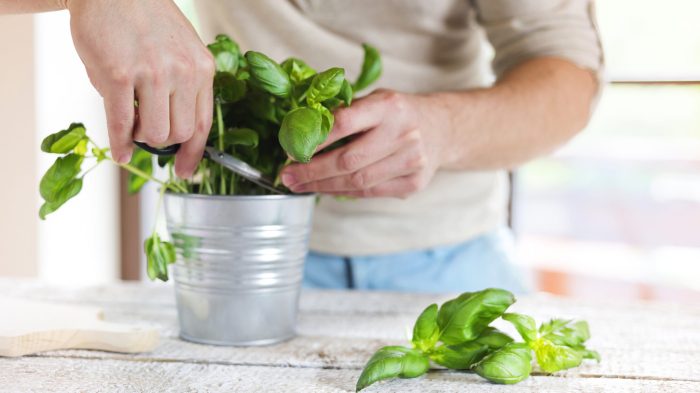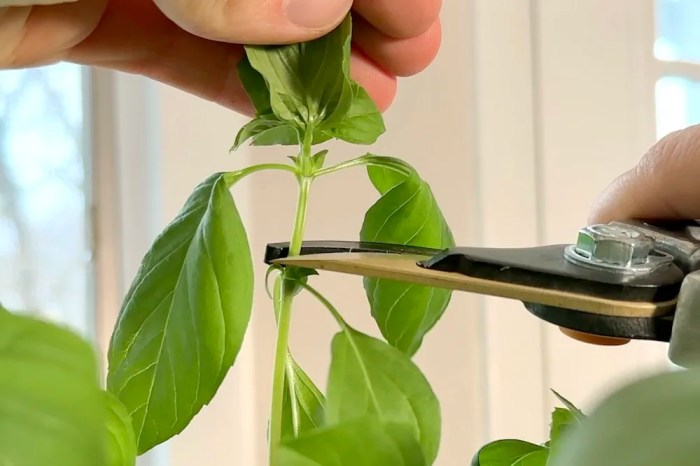How to trim basil plants – In the realm of culinary herbs, basil reigns supreme, and its cultivation requires a delicate touch. Trimming basil plants is an essential practice that can unlock their full potential, fostering robust growth, bountiful yields, and an explosion of flavors. Embark on this comprehensive guide to discover the intricacies of trimming basil plants, transforming your garden into a fragrant paradise.
By understanding the optimal timing, techniques, and troubleshooting common issues, you’ll gain the knowledge to nurture thriving basil plants that will elevate your culinary creations to new heights.
General Overview

Trimming basil plants is a crucial horticultural practice that offers a multitude of benefits. It promotes the overall health and productivity of the plants, resulting in enhanced growth, increased yields, and improved flavor.
Benefits of Trimming
- Enhanced Growth:Trimming removes excess foliage, allowing more sunlight and nutrients to reach the plant’s growing tips. This stimulates new growth and promotes a bushier, more compact plant structure.
- Increased Yields:By removing old or unproductive stems, trimming encourages the plant to focus its energy on producing new leaves and flowers. This leads to higher yields of flavorful basil.
- Improved Flavor:Trimming removes tough, fibrous stems and encourages the growth of tender, aromatic leaves. These leaves have a more intense and desirable flavor profile, making them ideal for culinary use.
Methods and Techniques
Basil plants require regular trimming to maintain their health, promote new growth, and enhance flavor. Several methods and techniques can be employed for trimming basil, each with its own advantages and suitability for specific situations.
The most common method of trimming basil is pinching. This involves gently squeezing the stem just above a leaf node with your thumb and forefinger and snapping it off. Pinching encourages the plant to produce new shoots and leaves, resulting in a bushier and more compact plant.
Cutting
Cutting is another effective method for trimming basil. Using a sharp knife or shears, cut the stem just above a leaf node at a 45-degree angle. Cutting promotes new growth and can be used to remove larger stems or branches that have become woody.
Using Shears
For larger basil plants or when trimming multiple stems simultaneously, using shears can be a convenient option. Hold the shears parallel to the stem and cut cleanly just above a leaf node. Shears provide a precise cut and can help maintain an even shape for the plant.
To maintain the lushness of basil plants, regular trimming is essential. This technique promotes bushier growth and prevents legginess. When trimming, cut back the stems by about one-third, just above a set of leaves. By providing ample light and water, you can encourage your basil plants to thrive.
For those seeking inspiration in their home decor, consider 10 Hanging Plants Revit Family Free Download: Enhance Your Designs with Realistic Greenery . This comprehensive guide offers a variety of Revit family models for creating stunning hanging plant displays in your designs, bringing a touch of nature indoors.
Timing and Frequency
The timing and frequency of trimming basil plants depend on several factors, including the plant’s size, growth stage, and growing conditions.
In general, it is best to trim basil plants regularly, about once every 4-6 weeks. This helps to encourage new growth, prevent the plants from becoming leggy, and promote bushier, more compact growth. However, if the plants are small or still in their early stages of growth, it is best to wait until they are a bit more mature before trimming them.
Trimming basil plants regularly encourages bushier growth and prevents flowering, which can make the leaves bitter. For optimal results, pinch off the top few sets of leaves above a node, where new growth will emerge. Interested in adding more greenery to your home? Check out 10 Hanging Plants Pinterest: Beautify Your Home with Greenery for inspiration.
Remember, regular trimming is essential for keeping your basil plants healthy and productive.
Optimal Time for Trimming, How to trim basil plants
The best time to trim basil plants is in the morning, when the plants are hydrated and the leaves are less likely to wilt. Avoid trimming basil plants in the evening, as this can make them more susceptible to disease.
Factors to Consider
- Plant size:Smaller plants may not need to be trimmed as often as larger plants.
- Growth stage:Basil plants that are still in their early stages of growth should not be trimmed as often as mature plants.
- Growing conditions:Basil plants that are grown in warm, humid climates may need to be trimmed more often than plants that are grown in cooler, drier climates.
Troubleshooting Common Issues

Basil plants are generally easy to care for, but certain issues can arise during trimming.
To keep basil plants healthy, regular trimming is crucial. By pinching off the growing tips, you encourage bushier growth and prevent flowering, which can reduce leaf production. For a comprehensive guide on elevating your home decor, consider exploring ” 10 Hanging Plants to Elevate Your Rental Apartment “. This resource offers valuable insights into creating a vibrant and inviting living space with hanging plants.
Returning to basil plant care, remember to trim off any yellowing or damaged leaves to maintain optimal health and appearance.
Common problems include yellowing leaves, stunted growth, and disease. Here are some solutions to these issues:
Yellowing Leaves
Yellowing leaves can indicate nutrient deficiency, overwatering, or insufficient sunlight.
Basil plants can be trimmed to encourage bushy growth and prevent them from becoming leggy. To trim, pinch off the top leaves of the stem just above a leaf node. If you’re looking for more ways to spruce up your home with greenery, be sure to check out the wide selection of hanging plants bunnings has to offer.
With their variety of sizes, shapes, and colors, you’re sure to find the perfect plant to complement your décor. Returning to the topic of basil plant trimming, remember to trim regularly to keep your plants healthy and productive.
- Ensure the plant receives adequate sunlight (at least 6 hours daily).
- Check soil moisture and water only when the top inch of soil feels dry to the touch.
- Fertilize the plant monthly with a balanced fertilizer.
Stunted Growth
Stunted growth can result from insufficient nutrients, root rot, or pests.
- Fertilize the plant regularly.
- Inspect the roots for rot and remove any affected areas.
- Check for pests and treat accordingly.
Disease
Basil plants can be susceptible to diseases such as downy mildew and basil blight.
- Provide adequate air circulation to prevent moisture buildup.
- Remove and destroy any infected leaves or plants.
- Use fungicides as necessary.
By addressing these common issues, basil plants can be kept healthy and productive.
Tips and Tricks

Trimming basil plants effectively requires the right techniques and a few helpful tips and tricks. These include selecting the appropriate tools, avoiding over-trimming, and promoting healthy basil growth.
When trimming basil, it’s essential to use sharp, clean shears or scissors. This ensures precise cuts and minimizes damage to the plant. Avoid over-trimming, as this can weaken the plant and reduce its productivity. Instead, trim only the top few leaves or stems, leaving at least two sets of leaves on each stem to encourage new growth.
Promoting Healthy Basil Growth
To promote healthy basil growth, regular trimming is crucial. By removing old or damaged leaves, you make way for new, healthy growth. Additionally, pinching back the tips of stems encourages bushier plants with more leaves. Fertilizing basil plants monthly with a balanced fertilizer will also support their growth and vitality.
Final Wrap-Up: How To Trim Basil Plants

Mastering the art of trimming basil plants empowers you to cultivate a thriving herb garden that will reward you with an abundance of fresh, flavorful basil. Remember, patience and observation are key to understanding the unique needs of your plants.
Embrace the journey, experiment with different techniques, and witness the transformative power of proper trimming on your basil plants.
Key Questions Answered
Why is trimming basil plants important?
Trimming basil plants promotes healthy growth, increases yields, and enhances flavor by removing excess foliage, encouraging air circulation, and stimulating new growth.
When should I trim my basil plants?
The ideal time to trim basil is when the plants are actively growing and have developed several sets of true leaves. Avoid trimming during hot or dry weather.
How often should I trim my basil plants?
Trim your basil plants every 4-6 weeks or as needed to maintain a compact and bushy shape. Regular trimming encourages the production of new leaves and prevents the plant from becoming leggy.
What are the different methods of trimming basil plants?
Common methods include pinching, cutting with scissors or shears, and using a basil stripper. Pinching is suitable for removing small tips of stems, while cutting allows for more precise removal of larger branches.